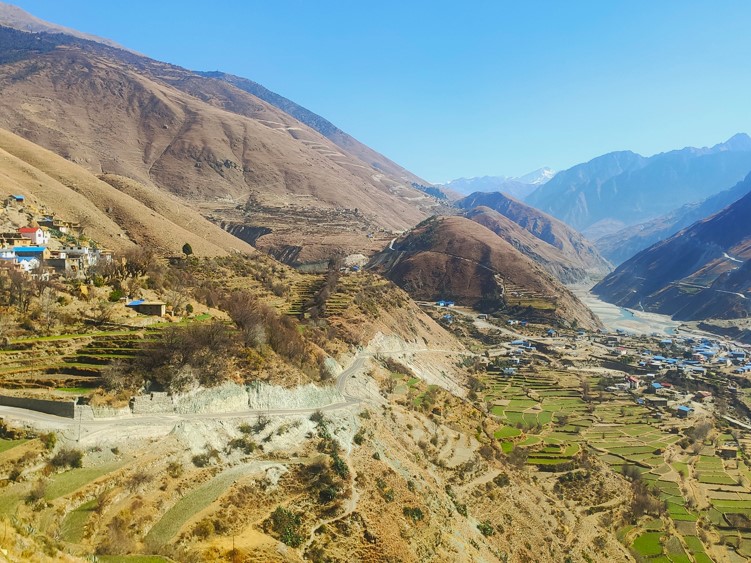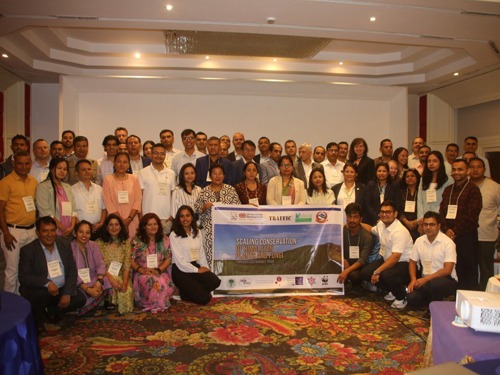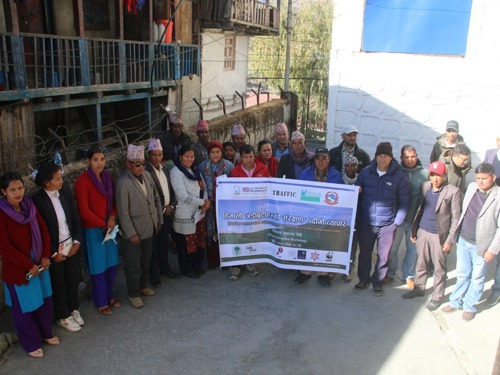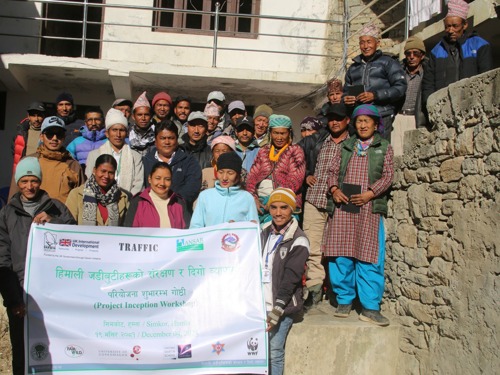Improving incomes and food security

Remote hills are reservoirs to high valued medicinal plants and fungi. Credit - Dipesh-Pyakurel, ANSAB.
A new project launched by TRAFFIC and partners aims at improving the lives of many thousands of people who harvest wild plants and fungi in the high mountains of Nepal.
The Himalayas are a global biodiversity hotspot teeming with life, but facing an existential threat. Overharvesting of precious plants and fungi, combined with climate change and unsustainable international trade, are threatening these ecosystems, and the livelihoods of those who depend on them.
TRAFFIC will work over the next five years in partnership with ANSAB, FECOFUN, FairWild Foundation, University of Copenhagen, University of Oxford, Tribhuvan University, and WWF India to safeguard vast stretches of this iconic landscape. Building on six years of previous work in the high Himalayas, this project is allowing the expansion of successful approaches to reach even more harvesters, communities, species, and landscapes.
The project ‘Scaling conservation of Himalayan plants and fungi through sustainable trade’ - or simply, SHIFT - aims to improve income and food security in the region by providing training and resources to 20,000 local harvesters, promoting the sustainable harvesting and trade of high-value medicinal plants and fungi like Jatamansi (Nardostachys jatamansi), Kutki (Neopicrorhiza scrophulariiflora), Yarsagumba (Ophiocordyceps sinensis), and Guchichyau (Morchella esculenta), among others.
The project employs a multi-faceted approach, including work to build capacity of harvesters, improved sourcing practices within the herbal products industry, strengthened national and regional policies related to sustainable non-timber forest product (NTFP) trade and investments into sustainable resource management of key species.
One of the key aspects of this project is its emphasis on collaboration and community involvement. Through a series of workshops held at national, provincial, and district levels, the project has already successfully engaged a diverse range of stakeholders. These workshops have not only facilitated knowledge sharing and capacity building but have also fostered ownership and collaboration.
A national-level inception workshop in August 2024 was attended by approximately 70 participants, including Nepal’s Secretary of Ministry of Forests and Environment, Director Generals from Department of Plants Resources, and Forest Research and Training Center, as well as representatives from different government offices, civil society organisations, bilateral and multilateral agencies, private sector, associations, and universities. The Secretary of the Ministry of Forests and Environment, serving as the chief guest, emphasised the importance of conserving and sustainably using high Himalayan NTFPs, while highlighting the potential of this project to contribute to Nepal's conservation goals. The Director General stressed the importance of stock quantification of NTFPs of high economic and conservation value, a task to be undertaken by the government, and commended the project for assisting government in conducting resource inventories of these NTFPs.

In ten Himalayan districts, district level inception workshops were completed by December 2024. Led by ANSAB with support from FECOFUN, these workshops saw the presence of divisional forest officers, park wardens, conservation area officers, and other stakeholders working in the district. The workshop participants were able to contribute their ideas for priorities to tackle under the project, such as requesting the inclusion of additional traded NTFPs in the resource inventory work planned for 2025, such as Pakhanved (Bergenia purpurascens) in Taplejung, Bajura and Humla, and Nirmasi (Delphinium denudatum) in Jumla, and Gorkha district. Divisional Forest Officers and other participants appreciated the project's activities and anticipated positive outcomes, with their request reflecting their trust in the initiative.


Three provincial-level sharing meetings were held at Provincial Forestry Ministries in Sudurpaschim, Karnali, and Lumbini provinces with provincial secretaries, ministry personnel, provincial forest directors, and provincial Forest Research and Training Centers in January 2025. All three provincial forestry secretaries expressed their commitment to support the project partners in achieving the outcomes by directing and coordinating with division forest offices, which are under the jurisdiction of provincial forestry ministries.
As part of the project's inception, a high-level field visit was organised in Dolpa district, including the Secretary and Joint Secretary of Ministry of Forests and Environment, the Director General of Forest Research and Training Center, and the Divisional Forest Officer of Dolpa. During the visit, the Secretary said, "This is an important project, and activities mentioned in this project - especially the resource inventory of selected 11 high Himalayan medicinal plants and fungi will serve as a foundation in setting the annual harvest quota for division forest offices in their management plans, and will be key to their sustainability in the wild."
Alongside the roll-out of the national, provincial and district-level workshops, the project has been laying the groundwork for the initiation of activities at the field-level. A network of local resource persons (LRPs) is being identified and will participate in a comprehensive capacity building programme, to enable them to facilitate work with local communities on the development and application of sustainable harvesting techniques. ANSAB and FECOFUN are also planning a training programme over the coming months to build the capacity of the network of Community Forest User Groups participating in the project, covering topics such as organisational governance, bookkeeping and accounting, women's rights and social inclusion.
The SHIFT project, by fostering emphasis on community engagement, capacity building, and sustainable resource management, has the potential to bring significant positive change on the Himalayan ecosystems and the communities who depend on them.
Written by Bryony Morgan and Dipesh Pyakurel. For more information on this Darwin Initiative Extra project DAREX012, led by TRAFFIC International, please click here.

 Back
Back